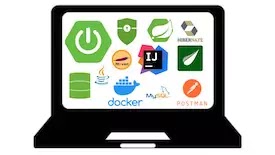🎓 Top 15 Udemy Courses (80-90% Discount): My Udemy Courses - Ramesh Fadatare — All my Udemy courses are real-time and project oriented courses.
▶️ Subscribe to My YouTube Channel (178K+ subscribers): Java Guides on YouTube
▶️ For AI, ChatGPT, Web, Tech, and Generative AI, subscribe to another channel: Ramesh Fadatare on YouTube
🚀 Introduction: Choosing the Right API Architecture
APIs are the backbone of modern applications, and two leading architectures dominate API development:
✔ REST API – The traditional, widely adopted API standard.
✔ GraphQL – A flexible, modern alternative that reduces over-fetching.
📌 Key Differences:
| Feature | REST API | GraphQL |
|---|---|---|
| Data Fetching | Fixed endpoints, may over-fetch or under-fetch | Fetch exactly what you need |
| Performance | Multiple round trips | Single query, optimized response |
| Flexibility | Rigid structure | Highly flexible |
| Learning Curve | Easy | Moderate |
| Best For | Simpler applications, well-defined resources | Complex, dynamic applications |
Let’s compare GraphQL and REST API in performance, flexibility, scalability, and security to help you decide the best option for your project.
1️⃣ What is REST API?
🔹 REST (Representational State Transfer)
✔ Uses HTTP methods (GET, POST, PUT, DELETE).
✔ Fixed endpoints for structured API design.
✔ Stateless communication – No session persistence.
✅ Example: REST API Endpoint Structure
GET /users/1
📌 Returns a fixed response with all user details.
✅ Example: REST API JSON Response
{
"id": 1,
"name": "John Doe",
"email": "john@example.com",
"orders": [
{ "id": 101, "total": 99.99 },
{ "id": 102, "total": 49.99 }
]
}
📌 Returns a pre-defined structure, even if the client only needs the user’s name.
2️⃣ What is GraphQL?
🔹 GraphQL (Query Language for APIs)
✔ Single flexible endpoint (/graphql) instead of multiple endpoints.
✔ Clients request only the fields they need (no over-fetching).
✔ Strongly typed schema for structured queries.
✅ Example: GraphQL Query
{
user(id: 1) {
name
email
}
}
📌 Returns only the requested fields.
✅ Example: GraphQL Response
{
"data": {
"user": {
"name": "John Doe",
"email": "john@example.com"
}
}
}
✅ More efficient, as unnecessary fields are not included.
3️⃣ Performance: REST vs. GraphQL
| Factor | REST API | GraphQL |
|---|---|---|
| Data Fetching | Over-fetching & under-fetching possible | Fetches only what is needed |
| Multiple Requests | Needs multiple endpoints | Single query handles everything |
| Speed | Slower for complex queries | Faster for complex queries |
📌 GraphQL is faster when querying multiple related resources, but REST is efficient for simple, well-defined requests.
🔹 REST API Performance Example (Multiple Requests Needed)
GET /users/1 → Fetch user data
GET /users/1/orders → Fetch user's orders
📌 Multiple requests = more latency.
🔹 GraphQL Performance Example (Single Query)
{
user(id: 1) {
name
orders {
id
total
}
}
}
📌 One request returns everything in a single response.
✅ Winner for Performance: GraphQL 🚀
4️⃣ Flexibility & Data Fetching
| Factor | REST API | GraphQL |
|---|---|---|
| Data Over-fetching | ✅ Yes (fixed structure) | ❌ No (only requested fields) |
| Custom Queries | ❌ No | ✅ Yes |
| Flexible Endpoints | ❌ No | ✅ Yes |
📌 GraphQL allows dynamic queries, whereas REST returns pre-defined responses.
✅ Winner for Flexibility: GraphQL 🏆
5️⃣ Scalability: Which One Handles Growth Better?
| Feature | REST API | GraphQL |
|---|---|---|
| Horizontal Scaling | ✅ Well supported | ✅ Well supported |
| Caching | ✅ Easy with HTTP caching | ❌ Harder (Requires custom caching) |
| Complex Queries | ❌ Can slow down with multiple requests | ✅ Handles multiple relationships efficiently |
📌 REST scales easily due to built-in HTTP caching, while GraphQL requires manual caching.
✅ Winner for Scalability: REST API ✅
6️⃣ Security: REST vs. GraphQL
| Security Factor | REST API | GraphQL |
|---|---|---|
| Built-in Security | ✅ Standardized authentication & authorization | ❌ Needs extra security measures |
| DDOS Protection | ✅ Easier with rate limiting | ❌ Harder (Single endpoint vulnerability) |
| Complex Query Risks | ✅ Safer with predefined responses | ❌ Query depth limits needed to prevent abuse |
📌 GraphQL is more vulnerable to malicious complex queries (e.g., infinite nested queries).
✅ Winner for Security: REST API 🏆
7️⃣ When to Use REST API or GraphQL?
| Scenario | Best Choice |
|---|---|
| Simple APIs with standard CRUD operations | ✅ REST API |
| Public APIs (e.g., OpenWeather API, Twitter API) | ✅ REST API |
| Complex data relationships (e.g., social media, e-commerce) | ✅ GraphQL |
| Mobile apps with limited bandwidth | ✅ GraphQL |
| Microservices communication | ✅ REST API |
📌 Use REST for simple applications and public APIs, and GraphQL for complex, data-driven apps.
🎯 Conclusion: REST API vs. GraphQL – Which One to Choose?
🚀 If you need simplicity & security → Choose REST API!
💡 If you need flexibility & efficiency → Choose GraphQL!
📌 Final Verdict:
✔ For simple, structured APIs: REST API ✅
✔ For complex, dynamic applications: GraphQL ✅
✔ For hybrid use cases: Combine REST & GraphQL!
💡 Which API style do you prefer? Drop a comment below!
🔗 Bookmark this guide for future reference! 🚀




![[NEW] Full-Stack Java Development with Spring Boot 4 & React Build 5 Spring Boot Projects with Java: Line-by-Line Coding](https://img-c.udemycdn.com/course/750x422/5338984_4d3a_5.jpg)










Comments
Post a Comment
Leave Comment